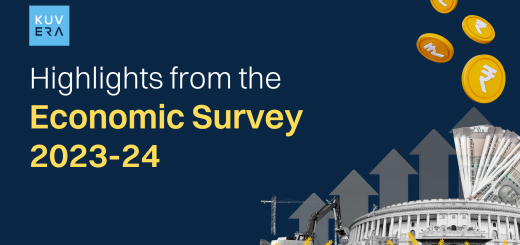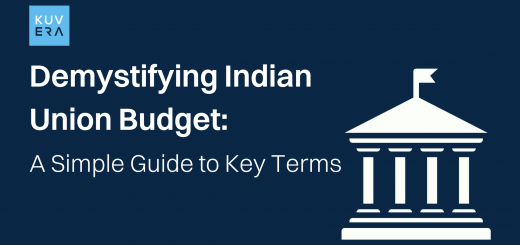Union Finance Minister Nirmala Sitharaman presented her 7th consecutive Union Budget 2024 in the Lok Sabha on 23 July 2024. She surpassed the record previously held by former FM Morarji Desai. This will be the first full budget of the National Democratic Alliance (NDA) government in its 3rd term under Prime Minister Narendra Modi. It marks his government’s 13th Budget since assuming office in 2014.
Here is all you need to know about Union Budget 2024-25.
Key Highlights From India’s Union Budget 2024
The theme of the Union Budget 2024-25 is Employment. Finance Minister Nirmala Sitaraman pointed out that the prime focus of the Union Budget is to promote employment and skilling, provide support to Medium, Small and Micro Enterprises (MSMEs) and empower the middle class. Envisioning the futuristic vision for ‘Amrit Kaal’, let’s see the highlights of the different segments of this year’s budget.
Income Tax
There have been major changes in income taxes in this year’s budget. Here are all the changes:
1. Standard Deduction For Salaried Employees:
from income from salaries will be increased from ₹50,000 to ₹75,000 from the next financial year. This deduction pertains to the salaried employees filing for taxes in the new tax regime.
2. New Tax Slab Under New Tax Regime For FY 2024-25:
The tax slab structure of the new tax regime has been changed. Here is the proposed one:
| Income Slab for FY 2023-24 (₹) | Tax Rate as per New Tax Regime for FY 2023-24 | Income Slab FY 2024-25 (₹) | Tax Rate as per New Tax Regime for FY 2024-25 |
|---|---|---|---|
| 0- 3,00,000 | 0% | 0- 3,00,000 | 0% |
| 3,00,000- 6,00,000 | 5% | 3,00,000- 7,00,000 | 5% |
| 6,00,000- 9,00,000 | 10% | 7,00,000- 10,00,000 | 10% |
| 9,00,000- 12,00,000 | 15% | 10,00,000- 12,00,000 | 15% |
| 12,00,000- 15,00,000 | 20% | 12,00,000- 15,00,000 | 20% |
| 15,00,000 above | 30% | 15,00,000 above | 30% |
Here’s an infographic explaining the new tax structure:
#Budget2024 brings changes to the New Tax regime. Good news to salaried taxpayers?
Tell us what you think. pic.twitter.com/DoZDr2FX36
— Kuvera (@Kuvera_In) July 23, 2024
3. Capital Gains:
Rates for capital gains have changed. Here are the changes:
| Before Budget 2024 | After Budget 2024 | |
|---|---|---|
| Short Term Capital Gains (STCGs) | 15% | 20% |
| Long Term Capital Gains (LTCGs) | 10% | 12.5% |
4. Exemption Limit For Capital Gains:
The exemption limit for capital gains which was previously ₹1 lakh is now ₹1.25 lakh.
Start investing in Index Funds.
5. STT Rate:
The Securities Transaction Tax (STT) rate increased from 0.01% to 0.02%. This will directly impact the Futures and Options (F/O) Traders while paying taxes on their gains.
6. Reassessment Of Tax:
The period to reassess your tax liability was up to a maximum of five years after the end of the assessment year. From the FY 2024-25, this reassessment period is only up to three years.
7. Definition Of Long Term Assets:
The listed financial assets held for more than one year will now be classified as long-term.
8. Changes in NPS:
The deduction of expenditure by employers towards the National Pension Scheme (NPS) has increased from 10% to 14% of the employee’s salary. This deduction is also for salaried employees in the private sector and public sector banks who file their taxes under the new tax regime. A new plan of the NPS for minors has been launched. It is called the NPS-Vatsalya. It is an NPS plan where the contribution is made by parents or guardians of the minors until they come of age. When the minor is 18 years old, the NPS-Vatsalya account is converted into a normal NPS account.
9. Resolution of Income Tax Disputes:
Vivad Se Vishwas Scheme will be used for resolving the pending income tax disputes.
Other Tax Reforms
Other taxes include corporate tax, GST and customs duties. Firstly, the corporate tax rate on foreign companies is 35% from FY 2024-25.
Basic customs duty on mobile phones and their essential accessories has been reduced to 15%. Custom duties on gold and silver are to be reduced to 6% and platinum to 6.4%.
Agriculture
In the agriculture and allied sectors, ₹1.52 lakh crore is proposed to be sent. Another 10,000 bioresearch centres will also be established. In the next two years, one crore farmers will be introduced into natural farming, which will be supported by branding and certification. The government is also planning to invest in 109 varieties of 32 different crops. To make India more reliant on pulses and oil seeds, 6 crore farmers and their land will be under the purview of farmer and land registry.
Employment And Skilling
Coming to this year’s budget, employment and upskilling the youth of this nation is of key importance.
1. Employee Linked Incentive:
Under this sector, three schemes under the PM’s Package: ‘Employee Linked Incentive’ has been introduced.
Scheme A: First Timers
Direct Benefit Transfers (DBTs) of one-month salary will be given in three installments up to ₹15,000 to first-time employees registered under the Employees’ Provident Fund Organisation (EPFO).
Scheme B: Job Creation In Manufacturing
From FY 2024-25, incentives will be given to both employees and their employers as per their EPFO contribution for the first four years of the employment.
Scheme C: Support To Employers
Reimbursement will be additionally given to employers up to ₹3,000 per month for two years towards their EPFO contribution for every employee they hire.
2. Boost to Skilling
Numerous training programmes and industrial institutes are being upgraded in this budget. 1000 Industrial Training Institutes (ITIs) are planned to be upgraded in hub & spoke arrangements in a span of 5 years. A key focus is on providing internships to the youth. The plan is to skill 1 crore youth by India’s top companies in five years. Plus a 12-month PM’s Internship will be provided with a monthly stipend of ₹5,000.
3. Emphasis on Women And Students
Apart from that, a special focus is on employing women and students and up-skilling them. The government plans on setting up working women’s hostels and creches with different industries. The Model Skill Loan Scheme will be revised to help with loans up to ₹7.5 lakh with a guarantee from a government-promoted fund. This is expected to help 25,000 students every year. Lastly, e-vouchers for loans up to ₹10 lakh for higher education in domestic institutions shall be directly given to 1 lakh students every year at an annual subsidised rate of 3% of the loan amount.
Inclusive Human Resource Development And Social Justice
The budget also plans on introducing more schemes of ₹3 lakh crore for benefitting women and girls. Next, more than 100 branches of India Post Payment Bank are to be set up in the North Eastern Region.
Manufacturing And Services
The main focus on manufacturing and services is on Medium Small and Micro Enterprises (MSMEs). The limit for MUDRA loans has been increased from ₹10 lakh to ₹20 lakh. MUDRA, which stands for Micro Units Development & Refinance Agency is a financial institution set up by the Government of India for the development and refinancing of micro units enterprises.
Urban Development
The major plan is not just to treat cities as cities but as growth hubs. The government plans on the development of peri-urban areas through economic and transit planning. Peri-urban areas are the ‘land in between’ the city and the farm areas, showing a mix of urban and rural features.
The Centre is also keen on providing water supply, sewage treatment and solid waste management projects and services for 100 cities. Cities, with a population above 30 lakh, will also have Transit Oriented Development Plans. The PM Awas Yojana Urban 2.0 will cover 1 crore poor and middle-class families. On top of that, 100 weekly ‘haats’ or street food hubs will be started in select cities.
Energy Security
In this sector, the three key plans are availability, accessibility and affordability. Under PM Surya Ghar Muft Bijli Yojana, there were more than 1.28 crore registrations and 14 lakh applications.
More research and development will be spent on small and modular nuclear reactors and newer technologies for nuclear energy. There is also going to be an energy audit of traditional micro and small industries in 60 clusters with a shift towards using cleaner energy.
Infrastructure
For the financial year 2024-25, capital expenditure would be ₹11,11,111 crore which is 3.4% of our Gross Domestic Product (GDP). The Ministry of Finance also plans on providing ₹1.5 lakh crore for long-term interest-free loans to aid infrastructure investment by the state governments.
The fourth phase of PM Gram Sadak Yojana (PMGSY) is projected to connect 25,000 rural areas. Projects such as the Kosi-Mechi intra-state link will improve the irrigation benefit programme. So, the government will provide a support of ₹11,500 crore for similar projects.
In case of flash floods, landslides and cloud bursts, assistance will be provided to states where flood management is crucial. Such states include Assam, Himachal Pradesh, Uttarakhand, Sikkim and other natural disaster-prone areas.
Tourism
The Finance Ministry is planning on making the Vishnupad Temple Corridor at Gaya and Mahabodhi Temple Corridor at Bodh Gaya into world-class pilgrim and tourist destinations. The Nalanda University is also to be revived as a national tourist centre. Next, Odisha is planned to become the ultimate tourist destination in India.
Innovation, Research And Development
The government expects the venture capital fund of ₹1000 crore to expand into the space economy by five times in the next 10 years. Secondly, Anusandhan Research Fund will be set up for research and prototype development. Lastly, private sector-driven research and innovation at a commercial scale are expected to encourage a pool of ₹1 lakh crore towards research and innovation.
Next-Gen Reforms
This sector had some additions from the previous budget. The central government plans to launch Jan Vishwas Bill 2.0 to improve the ease of doing business. It also plans on implementing newer technologies to speed up the digitalisation of the Indian economy. This includes improving data governance and management of sectoral databases.
FAQs about India’s Economic Survey
What is the Union Budget?
The Union Budget is an annual financial statement presented by the Government of India through its Ministry of Finance. It outlines the government’s estimated revenue and expenditure for the upcoming financial year, from April 1 to March 31.
Why is the Union Budget important?
The Union Budget is important because it determines the direction of policies and allocation of a country’s resources across various sectors, impacting economic growth, infrastructure development, social welfare programs, and overall national progress. It shapes the distribution of income, and reduces wealth and income disparities through taxes and subsidies.
Who prepares the Union Budget and when is it released?
The Union Budget of India is prepared by the Budget Division under the Department of Economic Affairs (DEA), which operates under the Union Ministry of Finance. This division is the nodal body responsible for producing the budget. The Union Budget is typically presented by the Finance Minister in Parliament on the first working day of February each year. Finance Minister Nirmala Sitharaman presented the Interim Budget 2024 on 1st February 2024 this year. After the government was re-elected in June, she presented the Union Budget 2024 on 23rd July 2024.
How is the Union Budget different from the Interim Budget?
The Union Budget is the annual financial statement of the government’s revenues and expenditures for the upcoming fiscal year. On the other hand, the Interim Budget is a temporary financial plan presented before the elections are conducted that only covers essential ongoing expenditures. The Union Budget is valid for the entire fiscal year, whereas the Interim Budget is only valid until the new government presents the full Union Budget. This year the interim budget was announced on 1st February 2024, while the union budget was presented on 23rd July 2024.
When was the first Union Budget presented in India?
The first Union Budget of independent India was presented on November 26, 1947, by R. K. Shanmukham Chetty, the then Finance Minister.
What are the main sections of the Union Budget?
The Union Budget consists of two main parts: the Revenue Budget and the Capital Budget.
1. Revenue Budget: This includes the government’s revenue receipts (tax and non-tax revenues) and the expenditure from these revenues.
2. Capital Budget: This includes capital receipts (loans, borrowings, and disinvestment proceeds) and capital expenditure on infrastructure, assets, etc.
How many parts is the Union Budget divided into?
The Union Budget of India is divided into four main parts when it comes to announcing budgetary changes. They are:
1. Revenue Receipts: This part of the budget estimates the revenue the government expects from various sources like taxes (income tax, GST, corporate tax, excise duty), fees from government services and penalties.
2. Revenue Expenditure: It includes the government’s expected expenses for daily operations, salaries, subsidies and essential public services. If the expenditure exceeds the receipts, it results in a revenue deficit.
3. Capital Receipts: This component includes receipts that increase the government’s liabilities or decrease its financial assets. It also contains loans from the public, state governments, foreign countries and selling treasury bills.
4. Capital Expenditure: This part covers expenses for creating long-term assets, infrastructure development and welfare facilities. It involves funds spent on equipment, machinery, infrastructure, construction and loans to states and territories.
What are revenue receipts?
Revenue receipts are the earnings of the government from taxes (income tax, corporate tax, GST, etc.) and non-tax sources (interest, dividends, fees).
What are capital receipts?
Capital receipts include loans raised by the government from the public (through bonds), borrowings from the Reserve Bank and other financial institutions, and money received from the sale of government assets (disinvestment).
What is the fiscal deficit?
The fiscal deficit is the difference between the government’s total expenditure and its total revenue (excluding borrowings). It indicates how much the government needs to borrow.
What is the process of budget preparation?
The budget preparation process involves:
1. Estimates Collection: Ministries submit their expenditure estimates.
2. Budget Division Review: The Budget Division of the Finance Ministry reviews and consolidates these estimates.
3. Cabinet Approval: The consolidated budget is discussed and approved by the Cabinet.
How is the Union Budget presented?
The Finance Minister presents the Union Budget in the Parliament, usually on the first day of February. The budget speech includes highlights of the budget proposals and key financial policies.
What happens after the Union Budget is presented?
After the budget presentation, it undergoes a thorough discussion in the Parliament. Members debate and scrutinize the budget proposals. After the discussion, the budget is put to vote, and, upon approval, it is implemented from the start of the new financial year.
How does the Union Budget affect taxes?
The Union Budget often proposes changes in tax rates and slabs. These changes can impact the amount of tax paid by individuals and businesses, influencing disposable income and savings.
How does the Union Budget influence prices of goods and services?
Budget proposals on indirect taxes like GST can affect the prices of goods and services. For example, a hike in GST on certain items can increase their prices.
Interested in how we think about the markets?
Read more: Zen And The Art Of Investing
Watch here: Investing in Focused Mutual Funds
Start investing through a platform that brings goal planning and investing to your fingertips. Visit kuvera.in to discover Direct Plans of Mutual Funds and Fixed Deposits and start investing today.
AREVUK Advisory Services Pvt Ltd | SEBI Registration No. INA200005166
DISCLAIMER: Mutual Fund investments are subject to market risks. Read all scheme related documents carefully. Registration granted by SEBI, membership of BASL (in case of IAs) and certification from NISM in no way guarantee performance of the intermediary or provide any assurance of returns to investors. Investments in securities market are subject to market risks. Read all the related documents carefully before investing. The securities quoted are for illustration only and are not recommendatory.












